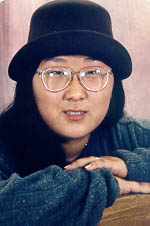|
RESEARCH
PROCEDURE
|
Donde, with the assistance of
predoctorate student,Jeong-Il Kim, will
create several DNA mutants using deletion and site-directed mutagenesis, express the mutant proteins in bacterial and yeast cells
and then characterize them using various techniques. |
| |
|
|
|

|
The initial phase of Donde's project requires
that they obtain mutated DNA. This mutation process is performed by
two separate processes, deletion and site-directed mutagenesis.
Deletion is the process of excising certain segments of DNA from the gene that
codes for phytochrome. The expressed phytochrome will then have
segments of amino acids missing. The second process Donde will
perform is site-directed mutagenesis. This process includes site-specific
changes in DNA nucleotides which substitute single residues in the
protein. The lab is focused on changing cysteine residues for serine
residues. The mutations then have to be amplified, verified and
purified using different vectors and lab processes. |
|
|
|
|
|
To get an overview of the process
that is involved in DNA cloning, click
here.
|
|
|
|
|
|
Donde's
research in creating mutated DNA plasmids, isolation and purification
procedures by clicking on the "Subcloning" Leaf. |
|
|
|
|
|
|
|
|
|
|

|
Protein Expression
involves the ligation of the recombinant plasmid into an expression vector
and then transforming the vector/plasmid into a host cell where the host
will produce a protein from the recombinant DNA. The intent is to be
able to identify functional changes in the phytochrome which will allow
Donde and Jeong-Il to identify the structure-function relationship of
phytochrome. |
|
|
The host cells
that Donde will be using are Escherichia coli and Pichia pastoris
(yeast). The E. coli is a prokaryote while the yeast is an eukaryote.
For an explanation of why E. coli and yeast are used as host cells, click
here. |
|
|
|
|
|
Donde's
research in phytochrome protein expression by clicking on the
"Protein Expression" Leaf. |
|
|
|
|
|
|
|
|
Structure-Function
relationships between the mutated phytochrome and cell photomorphogenesis
will be accomplished by several experiments. Unfortunately this will
not be performed by Donde this summer, hopefully she will get a chance to
come back to UNL and work on this project. |
|
|
|
|
|
|


